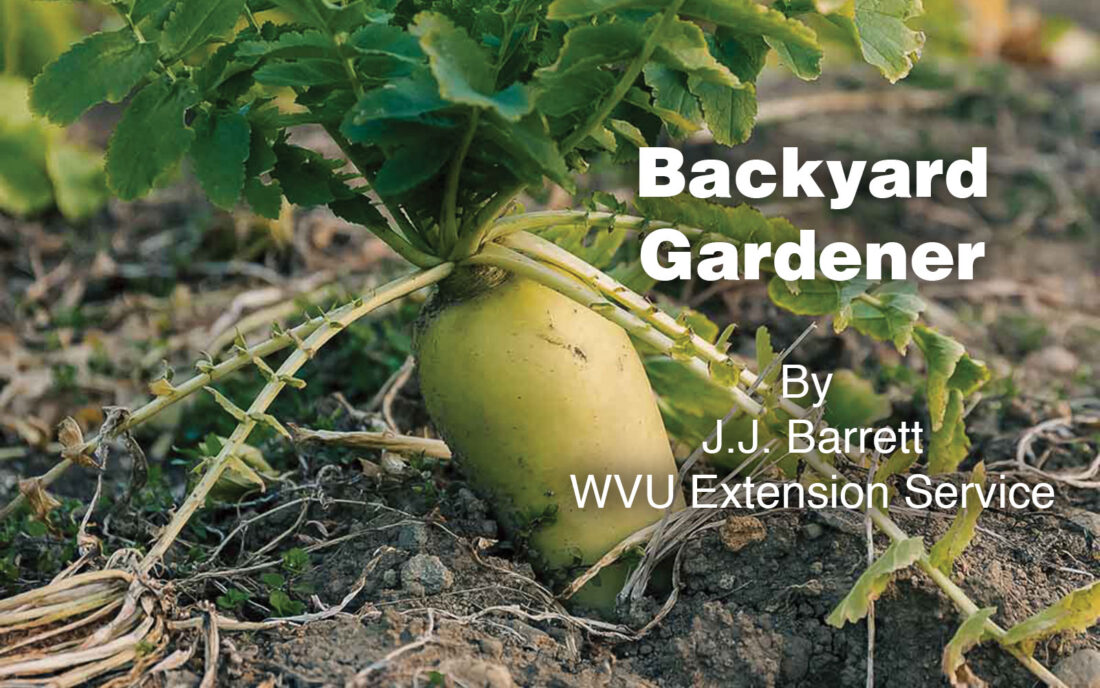Backyard Gardener: Tillage radish for reducing soil compaction

(Photo Illustration - Backyard Gardener)
Hello Mid-Ohio Valley Farmers and Gardeners! Hard to believe that Monday celebrated Labor Day, the end of summer here in the Valley. Many backyard gardeners are out there preserving the harvest by freezing, canning and drying vegetables and fruits.
After the extremely wet spring and early summer we experienced, things have dried up in our area. Hopefully, the recent storm front will bring us some much needed rain.
This week I want to talk about cover crops, particularly tillage radishes. Radishes are not only for the garden anymore. There are several types of radishes, and over the past decade tillage or daikon type radishes have become popular for uses as a cover crop. They are actually one of the hottest topics in farming for improving the soil.
Daikon radishes are members of the mustard family (Brassicaceae), which has a long history of use as animal feed as well as cover crops. The forage radish, also known as the daikon radish or Japanese radish, has a very large taproot. When they are planted in late summer, the radishes are not harvested but die in the winter, decay, and contribute a nitrogen store for spring planting. The radishes leave root channels so that soil dries and warms up faster in the spring.
These radishes have several valuable functions as a cover crop. The radish is well suited to perform many valuable cover crop functions, including providing soil cover, scavenging nutrients, suppressing weeds, and reducing compaction. This crop also is winter killed so there are less residue management challenges associated with many other cover crops.
Recent university research has documented the beneficial effects of radish cover crops on soil properties and subsequent crops. The seed industry has responded by ramping up production of radish seed and many new branded products are available.
The characteristic which most farmers and gardeners are interested in is their robust rooting ability. They can be utilized as a biological tool to reduce the effects of soil compaction, hence the nickname “tillage radish.”
Radish roots can extend more than three feet deep in 60 days, with the thickened storage portion of the root extending more than 12 inches under favorable growing conditions. Plants with roots more than one inch in diameter normally have a significant portion of the root exposed above ground, often more than 4 inches, even in uncompacted soils.
University of Maryland researchers found that forage radish roots can penetrate plow pans or other layers of compacted soil better than most other cover crops. The thin lower part of the taproot can grow to a depth of six ft or more during the fall. The thick, fleshy upper part of the taproot grows 12 to 20 inches long and creates vertical holes and zones of weakness that tend to break up surface soil compaction and improve soil tilth.
Tillage radish has a very flexible and aggressive growth habit and will spread out in a rosette to fill the space it is given. Radish plants, especially their fleshy roots, will become much larger when grown at lower plant densities.
When the cover crop dies in the winter and its roots decompose, the remaining root channels are used by the following crops to penetrate compacted deep soil layers. Research has shown four times as many corn roots penetrated compact subsoil after a forage radish cover crop than after winter fallow, and twice as many as after a rye cover crop.
In West Virginia, tillage radishes grow best when planted in late August or early September. However, a crop planted as late as October 1 has recovered significant amounts of nitrogen. Radishes planted in late September may be less susceptible to frost and more likely to overwinter. They work well in mixes for gardens and crops since only a few pounds are needed per acre. They fit well into corn silage and vegetable crop rotations that have openings for cover crop planting by the end of August.
There are many radish varieties available specifically for cover cropping including “GroundHog,” “Nitro,” “Sodbuster,” and “Bio-till” radish. These are large-rooted daikon-type oilseed or forage radishes which are similar to the large white daikon radishes traditionally used in Asian cooking.
Extension researchers recommend seeding at 8 to 10 pounds per acre using either a conventional or no-till drill or by broadcasting at 12 to 14 pounds per acre to establish a good stand of forage.
Gardeners should use a half-pound per 1,000 square feet. When using a drill, seeds are best planted between 0.25 inches and 1 inch deep. When broadcasting, use a cultipacker or do some very light disking to encourage seed to soil contact.
The tillage radish is tolerant of frost until temperatures dip below 25°F. It takes several nights of temperatures in the low 20’s to finally kill it out. Under the freeze/thaw winter conditions here in the Mid-Ohio Valley, radish shoots and roots will decompose rapidly once killed by frost. Contact me at the Wood County WVU Extension Office at 304-424-1960 or my email jj.barrett@mail.wvu.edu with questions. Until next time, Good Luck and Happy Gardening!
***
Question of the Week: What is killing the deer here in the Mid-Ohio Valley?
Whitetail deer in the Valley are being infected with a virus spread by biting gnats called Epizootic Hemorrhagic Disease (EHD). Hemorrhagic disease (HD) is a general term for illness caused by two related viruses: Epizootic Hemorrhagic Disease virus and bluetongue virus (BT).
Epizootic Hemorrhagic Disease primarily affects whitetail deer and can cause significant mortality events, particularly in the northern United States. Mule deer and pronghorn antelope are also affected. Cattle, sheep, and goats are also susceptible.
Disease due to these viruses are uncommon in cattle. Less than 5% of exposed cattle show recognizable signs. However, sheep can suffer severe disease and death from BT infection. Neither Epizootic Hemorrhagic Disease or bluetongue are a disease of humans.
EHD is a common and deadly disease of whitetail deer. These outbreaks occur periodically in West Virginia and some landowners can see significant sickness and death in local areas. Normally these outbreaks occur in late summer around August and September.
Whitetail deer typically experience a stress period in late summer when the quality and availability of edible vegetation like buds, leaves, twigs, and herbaceous plants decrease because of high temperatures and lack of rain. Drought can sometimes amplify and prolong this normal stress period.
Clinical signs of EHD in white-tailed deer usually begin approximately 7 days after infection. Fever and edema are common, and deer often have a swollen head, neck, tongue, or eyelids. Animals may have reduced appetite, weakness, and loss of fear of humans. Deer die quickly, within 8 to 36 hours.
HD is transmitted to an animal host by Culicoides midges, tiny biting flies commonly known as “no-see-ums” or gnats that are smaller than mosquitoes and other flies.
Diagnosis is based on the combination of clinical signs and virus testing on tissue and blood. Virus identification is essential to distinguish EHD and BT from other diseases of agricultural concern, such as Foot and Mouth Disease.
There is no treatment for HD in wildlife populations, and no wildlife prevention plan currently exists.






